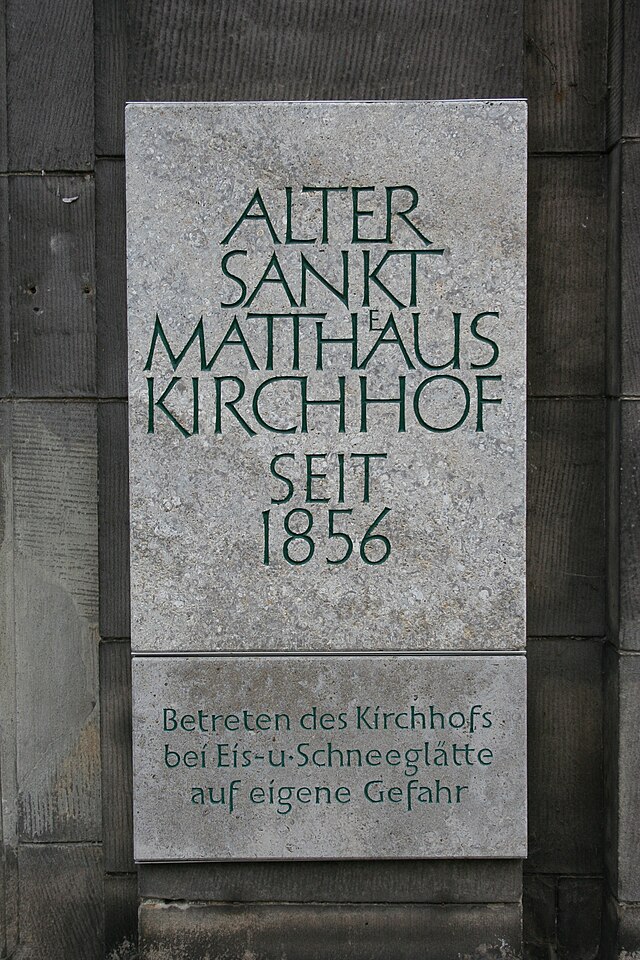Alter St.-Matthäus-Kirchhof
Cemetery in Berlin, Germany From Wikipedia, the free encyclopedia
Cemetery in Berlin, Germany From Wikipedia, the free encyclopedia
Alter St.-Matthäus-Kirchhof (Alter Sankt-Matthäus-Kirchhof or Old St. Matthew's Churchyard) is a cemetery in Schöneberg, Berlin, Germany.[1] It was established in 1856 by the Protestant parish of St. Matthew. It is known for its interment of the Brothers Grimm,[2] Rudolf Virchow,[3][4] Talaat Pasha,[5] and Claus von Stauffenberg.[6] As for Stauffenberg, his corpse was exhumed by the SS on 22 July 1944, the day after his burial, and cremated to remove any traces of him. His tombstone, however, remains intact.[7]


A Protestant parish named St. Matthäus (St. Matthew) was established in 1846 in southern Tiergarten area of Schöneberg. With the growing residents of eminent officials and scientists by the late 19th century, it became known as the "Privy Councilor's Quarters". The parish acquired a plot of land on the nearby hillside for their cemetery in 1854. It was first used for the purpose on 25 March 1856. It soon attracted even non-parishioners so that it had to be extended by 1883. To raise its value, interment fee for non-parishioners was increased in 1877. Due to impending saturation of the space, it was approved in 1890 that only the parishioners could use the cemetery. For non-parishioners, a new cemetery was created near the city. In 1909, a concrete funeral chapel was established in place of a small wooden chapel built in 1876. The artistic designs of the graveyard and chapel reflects the works of architects, sculptors, and artisans of the Prussian Empire. The German Reichstag planned to expand Berlin with demolition of the cemetery under Albert Speers' project. During 1938–1939, the northern section, covering one-third of the area, was demolished. The rest was to be done away by 1941. The government's investment in World War II led to loss of attention to the plan.[1] However, a number of graves were destroyed as Berlin was ravaged by the Allies towards the end of the war. The surrounding area, located between three rail lines, is known as "Red Island" as it served as a hotspot for anti-Nazi resistance.[8] The parish was dissolved in 2001, and the cemetery was taken over by the Evangelische Zwölf-Apostel-Kirchengemeinde (The Twelve Apostle Church) of Berlin. The City of Berlin had declared about 60 graves as heritage sites.[9]
| Year | Name | Notability | Image | Grave |
|---|---|---|---|---|
| 1859 | Wilhelm Grimm of Brothers Grimm | Academic, linguist, cultural researcher, lexicographer, author, folklorist. Known for tales such as Cinderella (Aschenputtel), The Frog Prince (Der Froschkönig), Hansel and Gretel (Hänsel und Gretel), Rapunzel, Rumpelstiltskin (Rumpelstilzchen), and Snow White (Schneewittchen). |  |  |
| 1863 | Jakob Grimm, the older Brothers Grimm | As above | On right above | On right above |
| 1887 | Gustav Kirchhoff | Theoretical physicist who identified black-body radiation and posited Kirchhoff's laws |  |  |
| 1891 | Leopold Kronecker with wife Fanni Kronecker | Professor of Mathematics at Berlin University |  |  |
| 1902 | Rudolf Virchow and wife Rose Virchow | Medical doctor, anthropologist, pathologist, biologist, politician; discoverer of the third tenet of cell theory, leukemia, chordoma, ochronosis. Variously known as "father of modern pathology", "father of modern medicine" or "father of social medicine". |  |  |
| 1920 | Max Bruch and wife Clara Bruch | German Romantic composer, teacher, and conductor who wrote over 200 works, including three violin concertos, the first of which has become a staple of the violin repertoire. |  |  |
| 1921 | Talaat Pasha (assassination of Talaat Pasha) | Ottoman grand vizier, main perpetrator of the Armenian genocide. Exhumed in 1943 and reburied in Istanbul.[5] | ||
| 1944 | Claus von Stauffenberg | German Army Colonel and executioner of the Operation Valkyrie to assassinate Adolf Hitler |  | |
| 2018 | Graciano Rocchigiani | German professional boxer |  |
Seamless Wikipedia browsing. On steroids.
Every time you click a link to Wikipedia, Wiktionary or Wikiquote in your browser's search results, it will show the modern Wikiwand interface.
Wikiwand extension is a five stars, simple, with minimum permission required to keep your browsing private, safe and transparent.